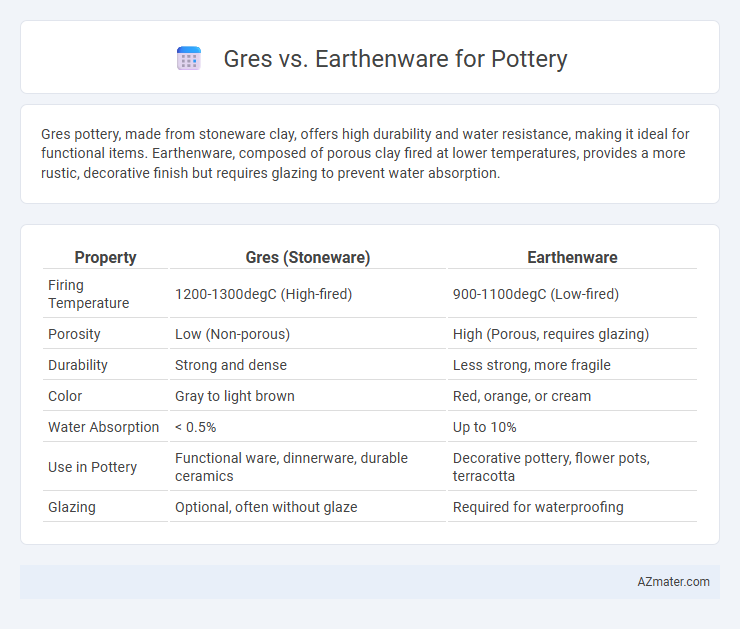Gres pottery, made from stoneware clay, offers high durability and water resistance, making it ideal for functional items. Earthenware, composed of porous clay fired at lower temperatures, provides a more rustic, decorative finish but requires glazing to prevent water absorption.
Table of Comparison
| Property | Gres (Stoneware) | Earthenware |
|---|---|---|
| Firing Temperature | 1200-1300degC (High-fired) | 900-1100degC (Low-fired) |
| Porosity | Low (Non-porous) | High (Porous, requires glazing) |
| Durability | Strong and dense | Less strong, more fragile |
| Color | Gray to light brown | Red, orange, or cream |
| Water Absorption | < 0.5% | Up to 10% |
| Use in Pottery | Functional ware, dinnerware, durable ceramics | Decorative pottery, flower pots, terracotta |
| Glazing | Optional, often without glaze | Required for waterproofing |
Introduction to Gres and Earthenware
Gres, known as stoneware, is a durable, non-porous type of pottery fired at high temperatures between 1,200degC and 1,300degC, resulting in a dense, vitrified body ideal for functional ware. Earthenware, fired at lower temperatures around 1,000degC to 1,150degC, remains porous and less durable unless glazed, often used for decorative or traditional ceramics. The key differences lie in their firing temperatures and physical properties, influencing their applications and longevity in pottery.
Material Composition: Gres vs Earthenware
Gres pottery, made from dense, fine-grained stoneware clay, boasts high silica content and is fired at higher temperatures, resulting in a durable and non-porous material. Earthenware consists of a more porous clay body with lower firing temperatures and a higher concentration of iron and other impurities, making it softer and more absorbent than gres. The difference in material composition directly influences water absorption rates, durability, and the final aesthetic of the pottery pieces.
Firing Temperatures and Techniques
Gres, or stoneware, is fired at high temperatures ranging from 1,200degC to 1,300degC, resulting in a dense, non-porous, and durable ceramic suitable for both functional and decorative pottery. Earthenware undergoes firing at lower temperatures between 950degC and 1,100degC, producing a more porous and softer ceramic body that often requires glazing to achieve water resistance. The firing techniques for gres involve more controlled and prolonged kiln atmospheres to enhance strength and vitrification, whereas earthenware can be fired in variable kiln environments and is more susceptible to temperature fluctuations.
Durability and Strength Comparison
Gres pottery, made from high-fired stoneware clay, exhibits superior durability and strength compared to earthenware due to its vitrified, non-porous surface that resists chipping and cracking. Earthenware, fired at lower temperatures, remains more porous and fragile, making it less suitable for heavy-duty use or frequent handling. This inherent difference in firing temperature and clay composition results in gres being ideal for functional pottery requiring long-term robustness.
Surface Texture and Aesthetic Appeal
Gres pottery features a dense, smooth surface texture with a slightly glossy finish that enhances its durability and modern aesthetic appeal. Earthenware exhibits a porous, rougher surface often left unglazed or painted with vibrant, rustic designs, giving it a warm, traditional look. The contrast between gres's refined, sleek appearance and earthenware's textured, handcrafted charm defines their distinct visual and tactile qualities.
Water Absorption and Porosity
Gres pottery, known for its low water absorption rate below 0.5%, features a dense and vitrified structure that significantly reduces porosity, making it highly durable and water-resistant. Earthenware, by contrast, exhibits higher water absorption typically between 5% to 15% due to its more porous composition and lower firing temperatures, resulting in greater vulnerability to moisture. This fundamental difference in porosity and water absorption directly impacts the suitability of gres for functional, waterproof ceramics compared to the more decorative or non-waterproof applications of earthenware.
Common Uses and Applications
Gres pottery, known for its high density and durability, is commonly used for functional items like dinnerware, tiles, and sanitary ware that require water resistance and strength. Earthenware, characterized by its porous nature and lower firing temperature, is primarily utilized in decorative pottery, garden planters, and traditional cookware due to its rustic appearance and ease of glazing. Both materials serve distinct purposes, with gres favored for practical, long-lasting products and earthenware chosen for aesthetic and ornamental applications.
Cost and Accessibility for Potters
Gres pottery typically commands a higher price due to its durability and high firing temperature, making it less accessible for beginner potters or those with limited budgets. Earthenware offers a more affordable alternative, as it fires at lower temperatures and uses readily available clay, making it common in small studios and educational settings. Cost-efficient materials and simpler kiln requirements make earthenware the preferred choice for potters prioritizing accessibility and budget constraints.
Environmental Impact and Sustainability
Gres pottery, made from high-fired stoneware clay, offers superior durability and lower porosity, which reduces the need for frequent replacements and conserves resources over time. Earthenware, fired at lower temperatures, typically absorbs more water and is less durable, resulting in shorter product lifespans and increased waste generation. The energy intensity of firing gres is higher, but its long-term sustainability benefits often outweigh the initial environmental cost compared to the more fragile earthenware.
Choosing the Right Clay for Your Pottery Project
Gres clay, known for its high density and durability, is ideal for creating functional pottery that requires strength and water resistance, such as dinnerware and outdoor planters. Earthenware, characterized by its porous and softer texture, suits decorative items and projects demanding lower firing temperatures, offering vibrant glaze possibilities. Selecting the right clay depends on the desired durability, firing temperature, and finish, with Gres providing toughness and earthenware allowing artistic flexibility.

Infographic: Gres vs Earthenware for Pottery
 azmater.com
azmater.com